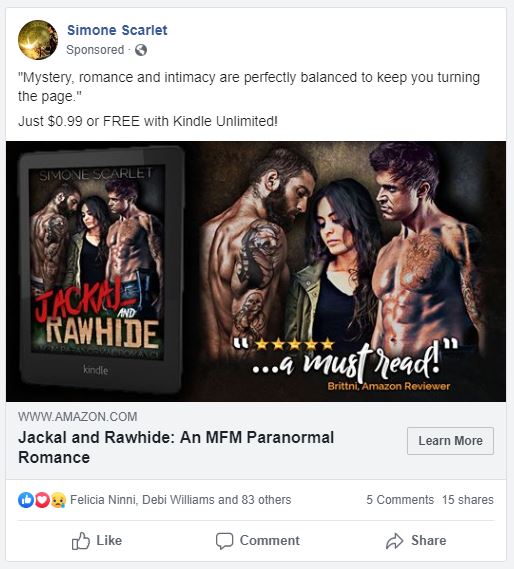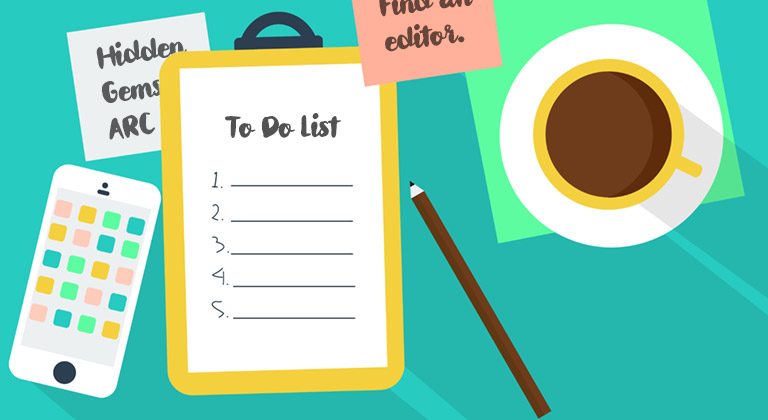How to Write Killer Facebook Ad Copy
One of the biggest complaints authors have about self-publishing is that they have to do their own marketing and advertising, which is why we spend so much time on the topic in our blog. And while we have covered Facebook ads in the past, there is at least one area where people still ask for help most frequently – writing the actual ad copy! That’s because when done right, Facebook ads can be a very effective tool for selling your books – but if you aren’t careful, they can just end up being very expensive! The key is in determining which combination of words will be most effective in drawing clicks to your book, so we have some tips for that.
I spent many years as an advertising copy writer in the New York advertising agency world, and if there’s one thing I learned it was that “shorter is better.” I think that all jumped the shark when I was still at work at 11:30pm, trying to come up with ‘copy’ for a graphic designer to squeeze into a website button. Forget about word count – I had five characters to work with!
But as frustrating as that experience was, it did teach me something important – that when it comes to advertising, less is often more. Unlike when a reader indulges in a book, advertising copy isn’t meant to entertain. It’s meant to grab a potential reader’s attention, and compel them to click the ‘buy now’ button.
This is especially true on Facebook, which remains one of my favorite advertising mediums. The learning curve with Advertising on Amazon is steep, while Facebook allows you to cut right to the quick, and target your new audience right where they expect you least; in among their feed of daily news and content.
That’s not a bad thing! If you’ve targeted your ads correctly, your advertisement could be exactly what they’re looking for.
But while we’ve written extensively about advertising on Facebook, there’s one area we haven’t really done a deep dive into, and that’s the magical copy which appears in your post, as a supplement to your picture or graphic. With Facebook tightening down the rules about having words or copy in the graphical element of your advertising image, this little section is often the only opportunity you’ll have to get the essentials across.
So, what do you write? How do you craft ad copy that sells?
Let me show you.
The elevator pitch – on steroids!
In advertising, there’s a thing called ‘the elevator pitch’ which is where you distill your sales treatment down into a concise format you can blurt out while sharing an elevator with some big, fancy decision maker. Movie producers have the same thing – for example, Aliens was described as “Jaws in Space.”
In an elevator, though, you have the benefit of a captive audience for 10 or 20 seconds. On Facebook, you have even less than that. You need to make your potential reader stop their mindless scrolling, and then give them something compelling enough to trigger them to click the ‘read more’ button.
Your graphic is what’s going to stop them scrolling – the big, fancy image you have as the meat and potatoes of your Facebook ad. It’s the words of your post, though, that’ll be what makes them think about clicking through. This is your elevator pitch – only its got to be shorter than even that!
In fact, the biggest mistake new advertisers make is writing too much – sometimes huge diatribes that force people to click the ‘read more’ button. You don’t want that. You have two or three sentences, maximum, to get your message across.
Since Mark Dawson is known as the go-to expert in Facebook marketing for authors, I’m going to show you one of his current ads as an example. Look at that headline – just 16 words! But within those words, there’s a lot of information.

“From the 3m selling author…” provides what marketers call ‘social proof’ – if three million readers have bought Mark’s books, they must be good!
“…of the John Milton series…” Since Mark uses very targeted audiences, it’s likely whoever sees this ad is going to know who John Milton is (after all, there are over three million readers!) With that in mind, the moment they see the name of the hero of their favorite thriller series, they’ll know what they’re in for.
The ending reveals that there’s a new character to discover, and this is clearly the first book in a new series – so it’s the perfect time to jump into reading it, because as Mark says: “…it’s time to meet Atticus Priest.”
…and that’s all she wrote, literally. Or he, in this case.
Any more than that, and people might not read it – but in the spirit of all great writers, Mark Dawson chose his words carefully. You should do the same.
The Price is Right!
Mark’s ad is a great example, but there are other approaches you can take. Ever since I started my career writing radio ads 20 years ago, I’ve been a huge fan of including the price of your product in the ad. Most advertisers balk at this – they think it’ll scare away potential customers, or make their product sound cheap. I believe the opposite. I think including the price of your product in an ad ‘pre-selects’ the people who will click on it – and when you’re paying by the click, this can save you a lot of money.
I’d rather get 10 clicks, one of which ends up being a customer, than 100 clicks, with the same ratio.
So, if your book is on free promotion, or part of Kindle Unlimited, be sure to mention that – “FREE with Kindle Unlimited.”
If your book is 99c, say that – just add a time limit, to get people to buy now, instead of leaving it for later: “Just 99c for a limited time.”
And if you’re selling your book for full price – say so! You spent weeks writing your book – it’s worth every penny of the $3.99 retail price, and if you include that, you’ll automatically screen out the time-wasters, and whoever clicks on the ad knows that they’ll be expected to pay $3.99 if they complete the buying cycle.
That doesn’t mean they will – but it makes it much more likely!
Adding Social Proof
Mark Dawson’s ad was effective because he could humble brag that he’d scored 3 million sales. Chances are, you’re not in that ballpark yet – but you can still have a humble brag of your own!
Another approach to validating ‘social proof’ is to take some of the copy from one of your best reviews, and use that! Advertising on Amazon won’t let you do this, but Facebook has no issue with it – and it works! Again, though, keep your copy short – so if you take this approach, you might have to ditch the ‘elevator pitch’ that worked so well for Mark Dawson.
Here’s an example from author Simone Scarlet, and you can see that not only did she include a quote from a review, but she also made sure to mention the price, just like I’d suggested above.

…and finally! 😂
This last one surprises a lot of people – but for some authors, the missing ingredient in their Facebook advertising copy are emojis.
Yes, those annoying yellow faces – smilies, and frownies, and lols – are actually a bright and distracting way to snap your potential reader out of their mindless scrolling and get them to read your ad copy.
Obviously, this might not be an option you want to choose – and it might definitely not be a good match for your book – but I’ve found it to be wildly effective at improving my advertising effectiveness, and now I do it as a matter of course. As always, your mileage might vary – but if it’s appropriate, I’d certainly try it with a campaign at least once.
Here’s a post I published on my own account last year, and the combination of the bright graphic and compelling emojis certainly got plenty of people to stop and take a look. Once they’ve clicked through, though, you’re on your own – and remember, advertising never cost you sales. If you are getting clicks but not sales, it’s time to examine your product, not your marketing.

Conclusion
It was Mark Twain who once wrote to his friend: “I didn’t have time to write a short letter, so I wrote a long one, instead.” That’s because, contrary to popular belief, it’s actually more difficult to write short copy, rather than long copy (that’s why my services were in such high demand as a copywriter. Nobody could cram more into those 5 characters than me!)
Look at Mark Dawson’s example and you can see a talented writer at work. 16 words, and yet he sells three different concepts – and that’s the kind of brevity you should aim for in your advertising.
The aim of an ad isn’t to sell your book – it’s to get potential readers to click through to your product page, and that will sell your book. Remember that, because it will change your perspective on advertising. Once you realize all you’re selling is a click, you suddenly see that it’s not a question about how much information you can cram into your copy, but how short and compelling you can make it.
Let me know what you think of my suggestions in the comment section below – and, yes, that includes the bit about emojis! I’d love to hear your take on the subject – and if you are interested in more about writing effective advertising copy, let me know and I’ll plan more posts like this in the future.












I’m getting ready to dive back into FB ads after a long break. This was a real shot in the arm! I love the challenge of writing short.
LOL on the Twain quip. Yep, simple is hard.
I can’t wait to incorporate some of these into my next FB ad! Thanks!
Great article. I think I’ll keep it as a reference for any time I’m creating an FB ad. Thanks for sharing.
Very useful points. Thank you for sharing. I’ll be bookmarking this for future reference.
Great reading
Great article. Always perceived emojis as unprofessional or too casual for ads but now I plan to give them a try!
Thanks for that. I’ve been using an old technique – which actually came from Mark – which requires three sentences. In recent times though when people are much more likely to look on their phones than their laptops I can see the benefit of the short, sharp message. Will be giving it a go today!